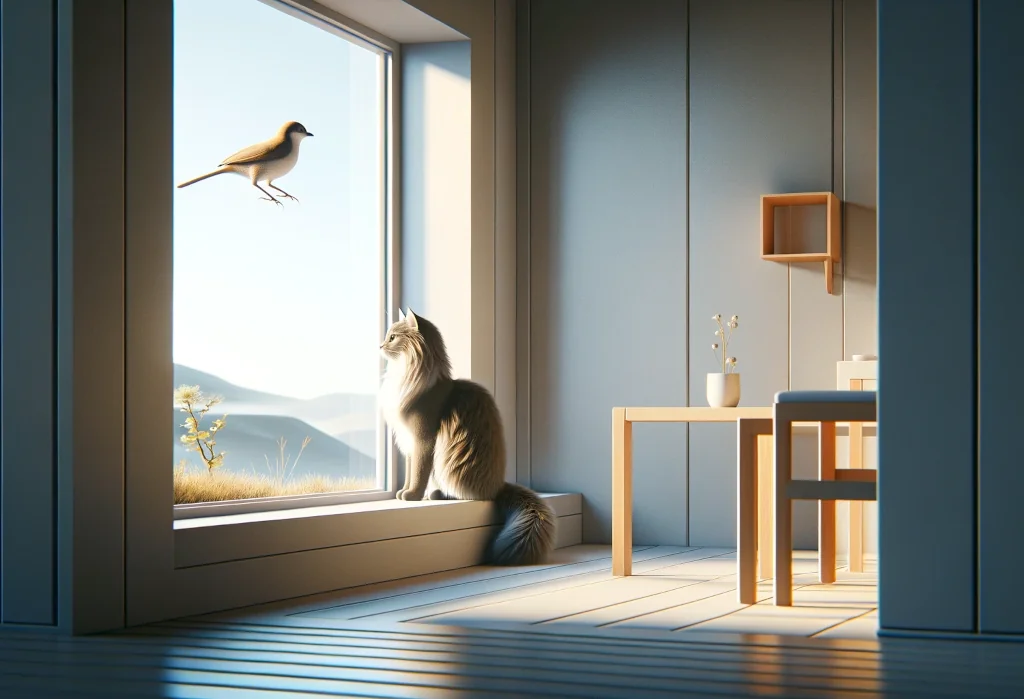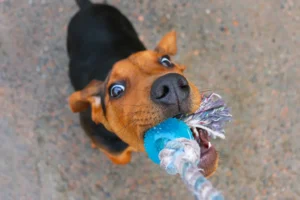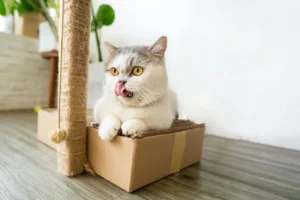Cats, those mysterious creatures that grace our homes with their presence, often leave us guessing what’s going on inside those fuzzy heads. Well, when it comes to indoor cats, there’s one thing for certain: their mental well-being is as vital as their physical health. Making sure your indoor cat is mentally stimulated isn’t just a nicety—it’s a necessity.
In this blog post, you’re going to discover the ins and outs of why keeping your feline friend’s brain busy is crucial and, more importantly, how you can do it.
Key takeaways:
- Engage your indoor cat with interactive toys and puzzle feeders to stimulate their hunting and problem-solving instincts.
- Recognize boredom signs like excessive sleep and lack of interest in play to address your cat’s mental health needs early.
- Create a diverse and enriching environment with vertical spaces, hiding spots, and new scents to keep your cat’s curiosity alive.
Why Is Mental Stimulation So Important for Indoor Cats?
Indoor cats live in a much more sheltered environment compared to their outdoor counterparts, who naturally encounter a variety of stimulations.
This does not mean, however, that their innate desires for hunting, exploring, and playing diminish. In the absence of natural stimuli, it’s crucial to provide indoor cats with mental challenges to keep their minds sharp and bodies healthy. Without proper mental stimulation, cats may fall prey to boredom, stress, or obesity, issues that can lead to more complicated health concerns down the line.
Cats are naturally curious creatures with a keen sense of exploration and a robust hunting instinct. By engaging these natural behaviors, mental stimulation can help maintain their physical wellbeing, prevent undesirable behaviors, and even enhance the bond between you and your furry friend. It’s about creating a stimulating environment that challenges them and enriches their daily lives.
What Happens When Cats Don’t Get Enough Mental Exercise?
When cats don’t get enough mental exercise, they may exhibit a range of behavioral and health issues that signify their need for more stimulation. Behavioral problems can include aggression, over-grooming, or even litter box issues, which are often expressions of stress or frustration. From a health perspective, a lack of mental engagement can lead to obesity, as cats turn to food for entertainment or eat out of boredom.
Moreover, the emotional health of your cat can suffer. Boredom can escalate into anxiety or depression, affecting their overall quality of life. In essence, mental health is just as paramount for cats as it is for humans, and neglecting it can lead to a cascade of issues that impact their well-being and your mutual happiness.
How Can You Tell If Your Cat Is Bored?
Identifying boredom in cats isn’t always straightforward since every cat’s personality and behavior are unique. However, there are some common signs to look out for:
- Excessive Sleep: While cats naturally sleep a lot, an unstimulated cat might sleep more than the typical 12-16 hours a day.
- Lack of Interest in Activities: If your cat isn’t showing interest in toys or playtime, it might be a sign they need more engaging activities.
- Overeating: Eating more than usual can be a sign of boredom, especially if your cat is always looking for food as a form of entertainment.
- Excessive Grooming: Over-grooming to the point of causing bald spots or irritation can be a sign of stress from a lack of stimulation.
One unique way to combat boredom many cat owners don’t consider is creating a ‘catio’ or a safe outdoor space for your indoor cat. It’s a fantastic way for them to experience the outdoors safely, providing fresh air, sunlight, and the thrill of outdoor life without the risks. A catio can range from a simple window box to a full-blown enclosure – the key is it allows your cat to tap into their wild instincts in a controlled environment.
Remember, understanding and addressing your cat’s need for mental stimulation goes a long way in ensuring they lead a fulfilled and happy life. Keep a keen eye on their behavior, get creative with their playtime, and make their surroundings as enriching as possible. Your cat isn’t just a pet; they’re a family member who thrives on love, attention, and an environment that engages their incredible instincts and intelligence.
What Can You Do to Keep Your Indoor Cat Mentally Stimulated?
Let’s dive right in, shall we? Keeping your kitty’s brain buzzing with excitement is not just a fancy idea—it’s a necessity for their overall health and happiness. So, how can you turn your home into a feline funhouse? Here are some pawsome ideas:
-
Interactive Toys : These are not your average catnip-filled mice. We’re talking about toys that mimic prey movements, such as laser pointers and motorized mice. They can keep your cat engaged for hours, pouncing and leaping just like they would in the wild.
-
DIY Puzzle Feeders : Get crafty and save some bucks! A simple DIY puzzle feeder can be as easy as cutting holes in a cardboard box or an empty tube. Hide treats inside and watch your furry friend solve the puzzle. It’s a great way to stimulate their brain and keep them from gobbling down their food too fast.
-
Playtime Schedule : Consistency is key. Setting aside regular playtimes can help alleviate your cat’s boredom and stress. Try to mix up the activities to keep things interesting. One day you could use a feather wand, and the next, a crinkly ball. The anticipation of what’s coming can be thrilling for them.
-
Training Sessions : Yes, you heard right. Cats can learn tricks too! From high-five to sit or even using the toilet, mental stimulation through learning new skills can be incredibly rewarding for both you and your cat.
-
Explore the Great Indoors : Create a safe outdoor experience with a catio or leash training. It’s a unique approach that allows your cat to explore the outside world safely, offering new sights, sounds, and smells.
Creating the Perfect Environment for Mental Stimulation
Creating a stimulating environment is just as crucial as interactive play. Think of it as setting the stage for your cat’s daily adventures. Here’s how you can turn your living space into a cat’s ultimate playground:
-
Elevate Their Perspective : Vertical spaces are a big deal for cats. They love to climb and observe their kingdom from a high vantage point. Wall shelves or tall cat trees can satisfy this desire. It’s not only good for their mental health but also encourages physical exercise.
-
Hiding Spots : Instinctively, cats seek out hiding places. These can be under the bed, behind curtains, or inside a cardboard box fortress. Such spaces allow them to retreat and feel secure whenever they need a break.
-
Regularly Introduce New Items : Cats are curious by nature. Bringing in new items occasionally, like a different type of scratching post or a new blanket, can spark their interest. The novelty doesn’t have to break the bank—a simple cardboard box can be an exciting discovery!
-
The Power of Scents : Here’s something most don’t consider—introducing scents. Cats have an incredibly keen sense of smell, and new scents can be fascinating to them. A sprinkle of catnip on their toys or a safe, new herb in the catio can provide a sensory experience they’ll love.
By weaving together interactive play with a stimulating environment, you not only cater to your indoor cat’s physical needs but, importantly, you nourish their mind. Remember, a bored cat can develop unwanted behaviors, while a mentally stimulated cat is likely to be happy, healthy, and bonded to you. So, let’s embrace these strategies, shall we? After all, seeing your feline friend’s eyes light up with curiosity and excitement is truly one of life’s simple pleasures.
Alex, a passionate animal lover, has experience in training and understanding animal behavior. As a proud pet parent to two dogs and three cats, he founded AnimalReport.net to share insights from animal experts and expand his knowledge of the animal kingdom.










